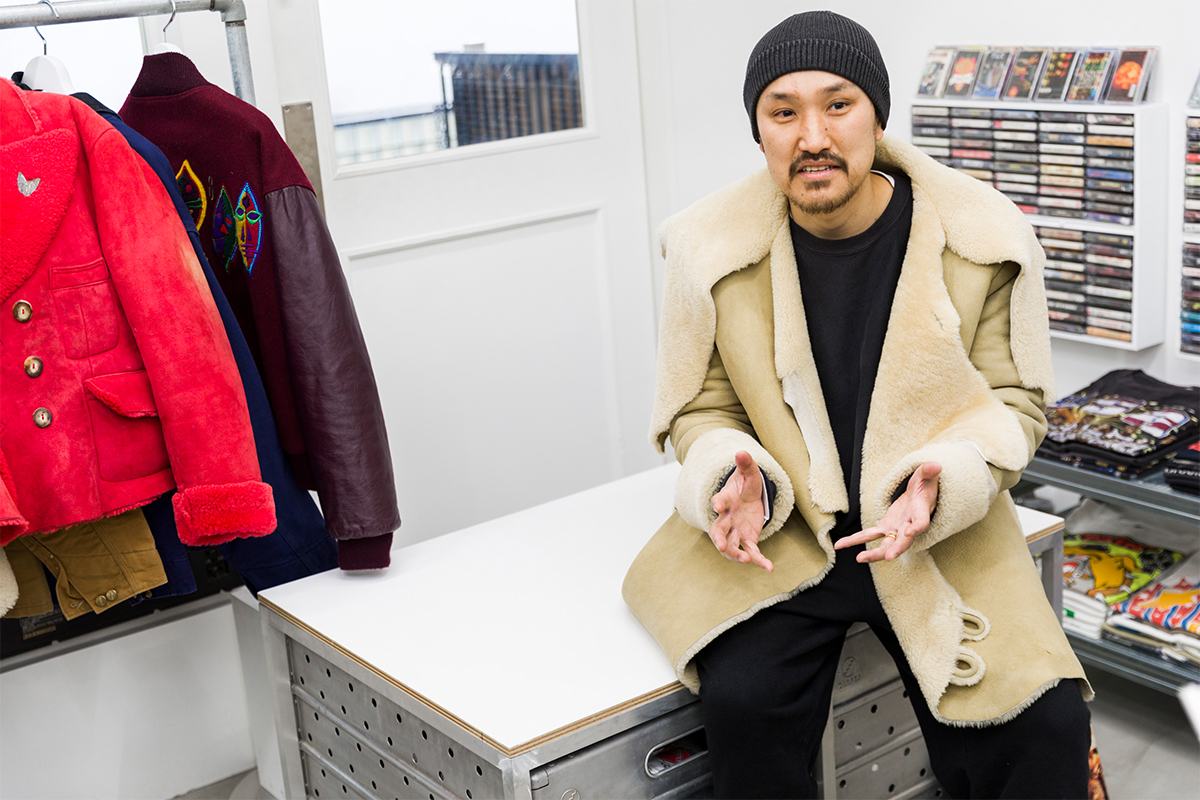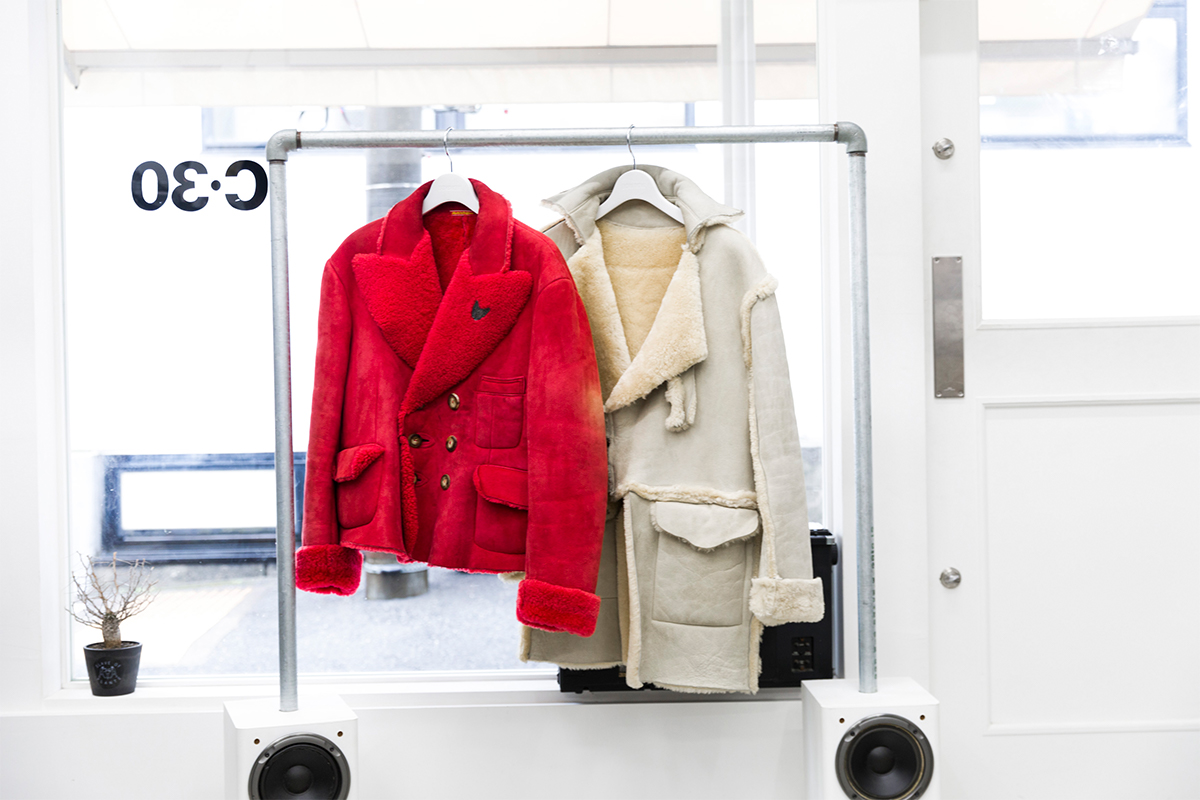TALKING ABOUT ARCHIVES Vol.17
Motofumi “POGGY” Kogi talks the relationship between archive and fashion; vol. 02, feat. Ken’ichi Gonmori (BOW WOW) (Part 1 of 2)
From high fashion to street fashion, the archive is a concept that cannot be left out when talking about fashion. What effect does the archive have on the creations made by each brand? In this new project, we will be joined by Ogi “Poggy” Motofumi and follow his dialogues with each guest. For this second instalment, our guest is Gonmori Ken’ichi, who after many years of working in the second hand fashion industry started his own brand, BOW WOW. This interview was conducted in his flagstore, C30, and brought directly to you.

--- To get things started, could you tell me how you guys first met? What is your connection?
Poggy: “The first time was probably when Gonmori was still working at this second-hand fashion store called LOSTHILLS in Harajuku. I remember seeing him back in the day, but I only had a proper conversation with him after being introduced to him by Konno, a friend who was working at NEXUSVII.”
Gonmori: “That’s right! I worked at LOSTHILLS for about eight years, but at that time I was handling more new items than second-hand items.”
Poggy: “You were also offering the service LOSTHILLS is known for: polishing sneakers!”
Gonmori: “Yes, I remember that like yesterday! So you knew about that!”
Poggy: “At the time, LOSTHILLS had their office on the second floor of the same building, and there was always a young employee there polishing the sneakers that had just come in.”
--- I see the both of you have a really interesting history! So it was only recently that you came to be on speaking terms?
Poggy: “Yes, probably these two, three years. I hosted an exhibition for Gonmori brand BOW WOW together with NEXUSVII a while ago as well. I think I visited C30 for the first time somewhere at the beginning of last year. The first time I walked past, the store just happened to be closed. But y’know, the place looked really interesting from the outside. So when I had another chance to visit, they had second-hand items there by brands like FUTURA, SUBWARE, STASH and the like; I thought their selection was really interesting. It was only afterwards that I found out it was Gonmori running the store.”


--- So the first time you just happened to walk past, what a concidence! When did C30 actually open?
Gonmori: “We only opened somewhere around March last year, which was just around the time Poggy came visiting. The brand itself has a lot of material that it lends from. If you think about it, second-hand items from the nineties were first sold around 20, 30 years ago, right? That means there’s already a lot of people alive today that weren’t there to experience the culture of those days. I’d been making clothes with that in mind for two or three years before I decided to start a store to sell second-hand clothes that can tell people about that ‘past’.”
--- I guess you could say it was this idea of ‘introducing the past’ that Poggy ended up liking.
Poggy: “Yeah, I guess you could say that.”
--- Mr Gonmori, could you say that cultural elements were one of the reasons you became interested in clothes?
Gonmori: “That’s where I started. Second-hand clothes, the Ura-Harajuku culture. At the time I read magazines like Boon, and went through all the phases like everyone does who loved second-hand culture; I also started buying vintage wear at that time, so my interests kept on growing wider and wider. I started C30 with the ideas of BOW WOW, so what I wanted was to make a selection of second-hand clothes I could really connect with those ideas. The core of the brand, so to say.”


Gonmori: “If I’m asked to introduce the brand, I felt it would be best to bring the items I can talk about most. For example, this buffalo jacket is one of the inspirations for the brand.”
Poggy: “I always had the feeling you have a preference for black and beige items, but I see you handle colourful items as well. I never knew that. This is from the eighties, right?”
Gonmori: “Actually, it’s from 1993.”

Poggy: “In the US, there used to be the people from The Wild Bunch who, while everyone was wearing adidas both top and bottom, were mixing those with items from Vivienne Westwood.”
Gonmori: “At BOW WOW, we also made some items based on the type of fur jacket that Milo from The Wild Bunch used to wear. Vivienne Westwood also happens to be my favourite designer overall. I probably wouldn’t wear them myself but I love for example the coloured woollen jackets by Vivienne Westwood.”
--- What kind of items have you been using as an inspiration for designing clothes for your brand, BOW WOW?
Gonmori: “Two and a half years have passed since we launched the brand, but I personally felt there weren’t that many brands that were designing their clothes to step into the shoes of that nineties culture. Of course, there were brands that tried to capture that nineties feeling, but I don’t think they quite managed to capture the culture element. I feel Malcom McLaren is most representative, the centre to all this street culture, so Hiroshi Fujiwara, who used to work with him, has taken some points from him. I love the stance that Malcom had in the early days, just blatantly copying a lot of stuff.”
--- You mean the fact that he straight-out sampled a lost of things?
Gonmori: “Yeah, that’s how he started out. The name of the brand, BOW WOW, is also related to him; after he did the Pistols, he went on to produce another band called BOW WOW WOW. Even the name of the store was taken from one of their songs which is called “C30 C60 C90 Go”. At the time, cassette tapes still had the overhand compared to records, and at that time Malcom Maclaren had the guts to tell people from his position to “dub that stuff like you mean it”, which of course was completely forbidden. That is the kind of image I wanted to have for my own brand.”

--- Poggy, what do you think is the legacy left on fashion these days by someone like Malcom McLaren?
Poggy: “There was this one time at Liquor, Woman & Tears that we received some items from JOHN PEARSE, a brand that Malcom McLaren made tailor-made items for like suits and shirts. In other words, he would be wearing suits while finding himself in a completely street environment, a kind of dumbed-down British Trad. That’s one thing I really love about him. Also, while he is mostly known as one of the people who started the punk movement, he would also go to New York, where he went to block parties and got into Hip Hop. We Japanese people, we tend to think of punk as punk, hip hop as hip hop, they’re different genres, we separate them on a different basis. So it’s interesting to see this flexibility between genres. I think people like Hiroshi Fujiwara and Jonio (Jun Takahashi) are similar to him in that aspect. Jonio would also be wearing punk clothes at the same time as Air Force 1 shoes; I think you could see McLaren’s influence in those kind of people.”
--- So he was one of the first ones to mix different fashion styles, which has become quite common with young people these days.
Poggy: “That’s right! His partner at the time, Vivienne, was also a person that would go completely in the other direction and destroy the historical ideas about design. Vivienne would do things like rip apart English classical designs or knit sweaters of mohair which were commonly worn by families at the time, or attaching a zipper to a piece of US Army pants and turning it into a kind of bondage pants. Destroying the traditional overcame the boundaries between fashion and music and turned it into a kind of culture, which is a really difficult thing to do.”

--- I get the feeling we’re talking about the beginning of what most of us think of when we talk about fashion just by listening to you.
Poggy: “You’re not wrong there. Like I just said, while in the US you could find people like Run DMC, The Wild Bunch represents the existence of Hip Hop in Britain, but it’s slightly different from the kind of mixing people did with Vivienne Westwood designs. I hear back in the days people like Kan Takagi and Hiroshi Fujiwara would also mix Vivienne items and The Wild Bunch and Tiny Punx would also be influencing each other, so it’s hard to tell just who came first, but it does feel more Hip Hop. I think Gonmori takes a lot of influence from those people.”
Ken’ichi Gonmori
The director of BOW WOW, who has roots in many places, like vintage, hip hop and other music styles and the culture found in Ura-Harajuku. This Spring/Summer season, he will be supporting the launch of their new brand, RECOGNIZE together with King of Diggin’ AKA MURO.
Motofumi “POGGY” Kogi
Born in 1976. Started working part-time at UNITED ARROWS in 1997 and opened his own store, Liquor,woman&tears in 2006 after working for the press for a while. In 2010, he opened a new store called UNITED ARROWS & SONS, where he worked as director. In 2018 he went independent and is gathering attention for his various activities, like working as the fashion director for 2G, a store in the recently renewed Shibuya PARCO building.
Text_ Maruro Yamashita




